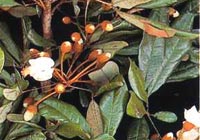 Catuaba (Trichilia Catigua) is a tree native to the northern Amazon and some parts of northern Brazil. It has orange and yellow flowers and bears an inedible oval-shaped fruit. The Tupi Indians first discovered its physiological and psychological benefits and boiled the Catuaba bark to produce a strong tea. The Tupi drank this concoction as an aphrodisiac, as well as to control anxiety, ease depression, improve memory, and relieve pain.
Catuaba (Trichilia Catigua) is a tree native to the northern Amazon and some parts of northern Brazil. It has orange and yellow flowers and bears an inedible oval-shaped fruit. The Tupi Indians first discovered its physiological and psychological benefits and boiled the Catuaba bark to produce a strong tea. The Tupi drank this concoction as an aphrodisiac, as well as to control anxiety, ease depression, improve memory, and relieve pain.
The Catuaba bark contains alkaloids, aromatic oils, cyclolignans, fatty resins, phytosterols, and tannins. Catuaba is actually a relative of plants used as sources of cocaine but it does not possess any addictive properties. Catuaba bark’s aphrodisiac properties became so popular in Brazil and neighboring areas as the Tupi shared its benefits to other tribes. A common saying among the tribes in the rainforest goes “Until a man is 60, the son is his. After that, the son is Catuaba’s.”
Brazilian herbalists believe that the composition or color of a fruit or herb (or its extract) indicates the organ or system that it benefits. Since the extract of Catuaba bark is red, they linked it to the circulatory system, blood, and the liver.
But the crimson color of Catuaba bark extract is more popularly known for its male enhancement properties. While Catuaba’s mechanism of action has yet not been fully explained, it has been used for hundreds of years to improve circulation by helping dilate and strengthen arteries. Better blood circulation and wider blood vessels mean improved erection quality. Catuaba is often used with Muira Puama, another aphrodisiac tree found in the Amazon. Both herbs can be found in many male enhancement supplements.
Aside from its male enhancement benefits, Catuaba has been shown to have antibacterial and antiviral properties. Japanese researchers found that Catuaba helped protect mice from E. Coli and staph infection, and prevented the rodents’ white blood cells from absorbing the AIDS-causing HIV virus.



















